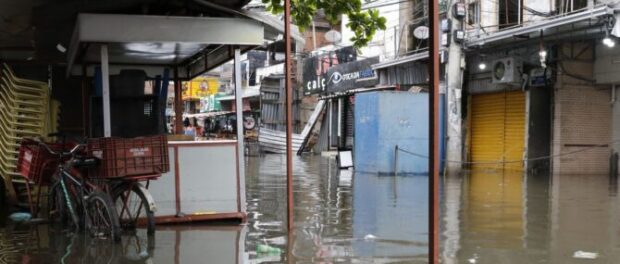
This article is part of a series created in partnership with the Center for Critical Studies in Language, Education, and Society (NECLES), at the Fluminense Federal University (UFF), to produce articles to be used as teaching materials in Niterói public schools.
The world is experiencing increasingly frequent extreme climatic events. Growing temperatures have altered the climate, producing intensified rain showers or record-breaking heat waves in many regions. This climate change is a consequence of a predatory development model of consumption and production. That is to say, human actions are responsible for these changes. This finding was outlined in the latest UN Intergovernmental Panel on Climate Change (IPCC) report released in February.
For a long time climate change has been a future concern, but the IPCC report makes clear that those impacts are already with us. According to the report, half of the world’s population is already living under climate risk. This scenario is even more serious for marginalized populations. In Brazil these are residents of favelas and peripheries, indigenous peoples, and quilombolas. These are the people who live in more vulnerable areas, which experience disinvestment by public authorities, with fewer resources to adapt to changes and extreme events.
Over the past decade, the number of deaths from droughts, floods, and storms in more vulnerable regions was 15 times higher than in less vulnerable ones. Reflecting on this brings us to the notion of climate justice, which emerges to claim and make visible the importance of environmental defense, security, and equity, and the common right to land, water, productive soil, clean air, and a balanced ecosystem.
The impacts of the climate crisis do not affect everyone equally. People and communities that are structurally cut off from public services suffer more profoundly with regard to environmental and climatic issues.
“Within the predictions of climate change, we have seen increasingly harsh extreme events such as long dry periods, rising temperatures, rain, and drought. We know that if a drought creates a shortage of water in big [Brazilian] cities, the places that will run out of supplies are the favelas. Morro da Providência already suffers, structurally and historically, from a lack of water,” explains Lorena Portela, co-coordinator of the Agroecological Providência project. As part of the Sustainable Favela Network (SFN)*, the objective of the initiative is food security and health promotion through education, agroecology, and environmental sanitation among children, youth, and women from Morro da Providência, located in Central Rio.
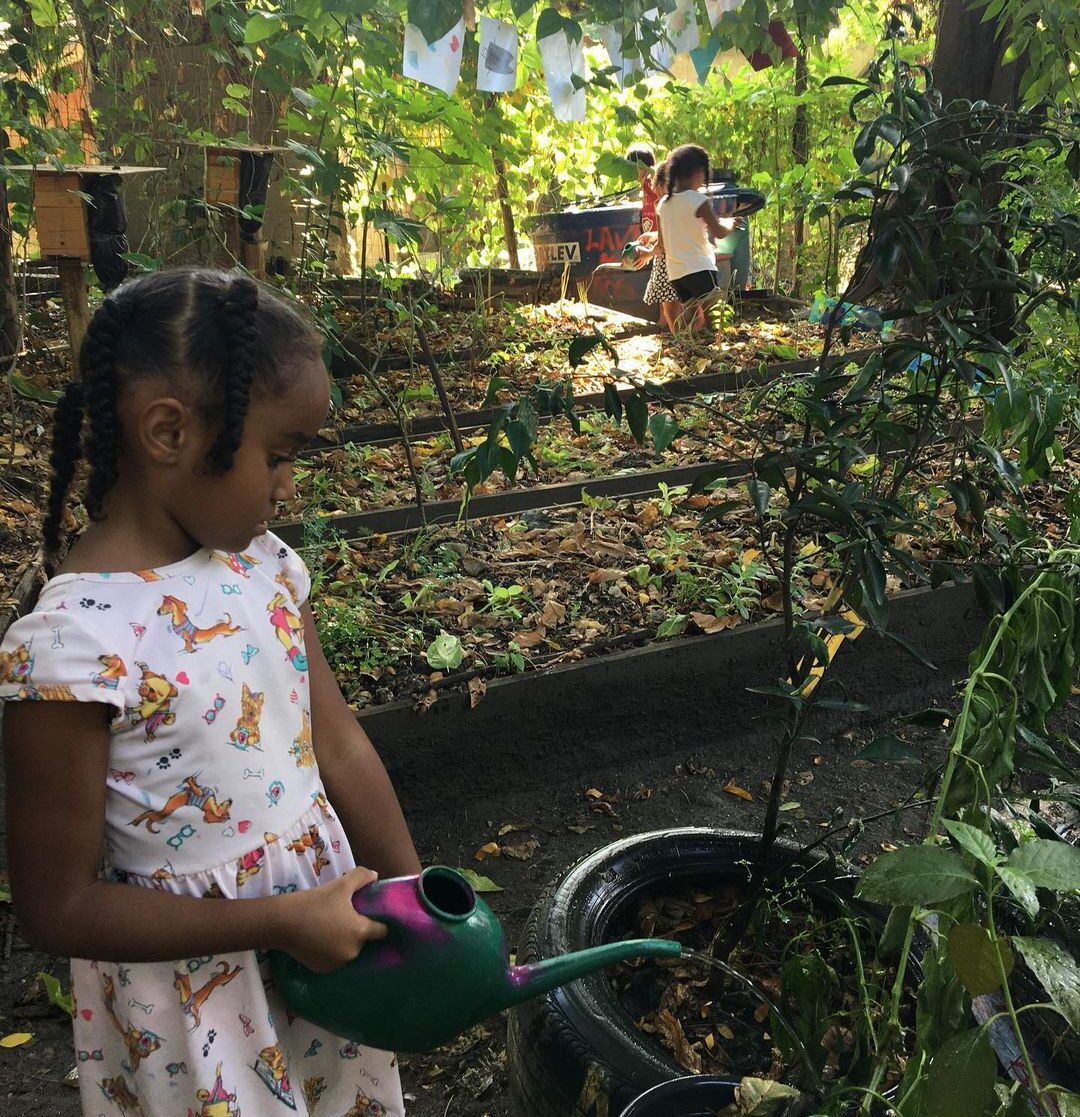
For Portela, climate justice is related to understanding which people are most affected by climate change and taking political action to change this reality. She argues:
“Climate change is a global problem, but it affects people unequally. Therefore, climate justice is understanding that the means to confront climate change have to be thought out locally and turn into policies for localized actions. In the case of the favelas, there is the whole issue of land that could collapse. All of this needs to be planned out because these are already vulnerable areas, areas that are underserved by the government.”
The unequal way in which the climate crisis affects populations is pivotal to understanding the idea of climate justice. It is also important to discuss who is primarily accountable for this problem. Richer nations, for example, are responsible for the largest amounts of greenhouse gas emissions but they experience the consequences of this worsening climate less when compared to developing countries. The Inequality Kills report, published by Oxfam, offers other significant data: the world’s richest 1% emit more than twice as much carbon dioxide than the world’s poorest 50%.
The climate injustice scenario is also shaped by the exclusion of those most affected by the consequences of the crisis from the debate and decision-making processes that surround it. In this sense, efforts to be present in spaces of visibility and discussion about climate and environment have generated good results. In November of last year, the 26th United Nations Conference on Climate Change (COP26) was held, which is the yearly meeting of the United Nations Framework Convention on Climate Change (UNFCCC).
Activists from around the world attended and met with a parallel agenda, bringing the interests and urgent needs of peripheral populations to the center of the debate. Favela leaders, representatives of quilombola and indigenous communities, and activists from the Brazilian Black Movement were at COP26, demanding a real commitment to climate justice and denouncing environmental racism and unequal access to natural resources.
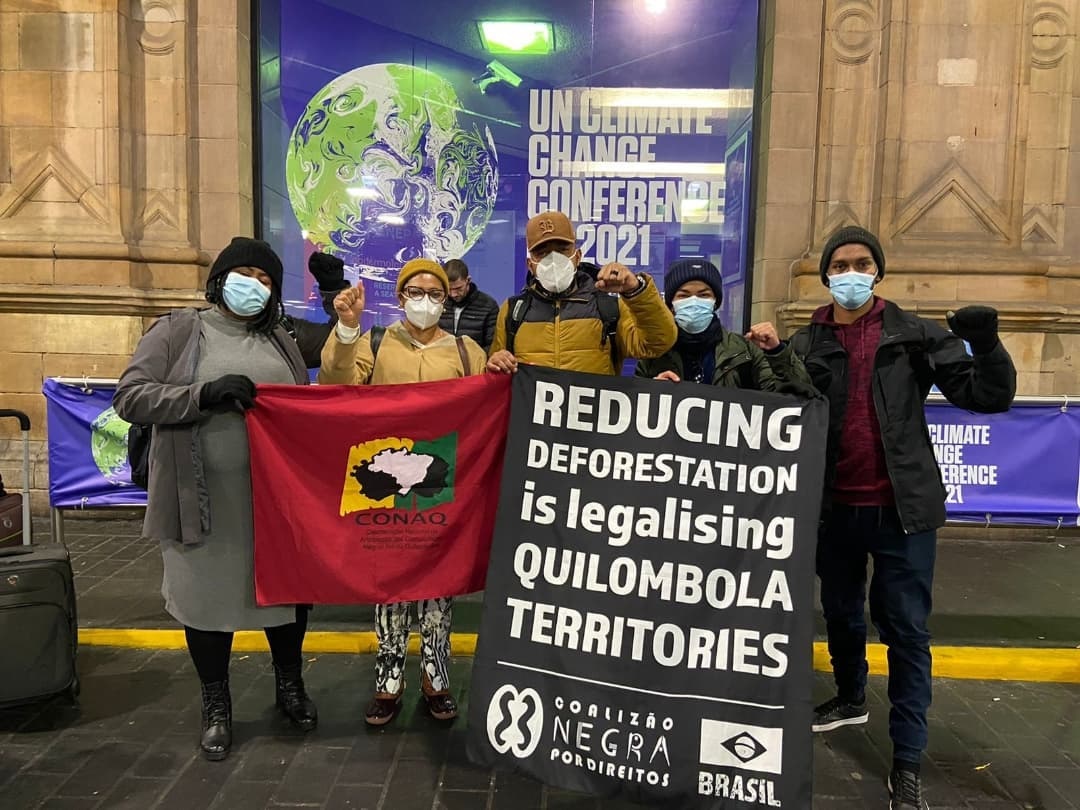
Several initiatives in the favelas of the Greater Rio metropolitan area have been working to introduce the discussion on climate and the environment to peripheral communities and individuals, engaging them to take ownership of the discussion. One such initiative is the Inclusion Project, from São João de Meriti in Greater Rio de Janeiro’s Baixada Fluminense region. The project has been working on the concept of climate justice, especially with children and adolescents, guiding them to use resources more cautiously. As explained by Élida Nascimento, coordinator of the Inclusion Project:
“We have been carrying out actions to raise awareness about sustainability on the planet with children, young people and adults through a live laboratory, through vegetable gardens, environmental education and healthy eating. We also try to plant trees in the community.”
Nascimento sees consumer culture as a great challenge to environmental education, however. “It’s been very difficult because commercial media influences exacerbated consumption all the time, which generates many consequences for nature,” said Nascimento.
Climate Justice As Seen By Members of Rio’s Sustainable Favela Network
Historically, favelas develop as solutions to guarantee shelter in the absence of state programs to ensure this basic need—that is to say, through the talents of the community and the potential of the people and projects of the territory itself. Despite the unequal context in which they emerge, favelas and peripheries produce models for the entire city.
Residents of Rio’s favelas members of the Sustainable Favela Network* are concerned about the sustainable future of their communities and about reducing the impacts caused by climate change on their territories. The network’s member projects work with environmental education, management of green areas, the use of renewable energy, and basic sanitation, among others.
Núbia Corrêa, coordinator of the Jacarepaguá Environmental Commission, has been a member of the Sustainable Favela Network for three years. She is founder of the Plantas do Quintal (Backyard Plants) project, which produces ornamental plants, Non-Conventional Food Plants (PANCs), and medicinal plants from the management of household waste for cultivation, resulting in income generation.
In Corrêa’s view, there is a close relationship between climate change and politics. “Right now it’s easier to talk about climate injustice. There is no way to separate environmental [in]justice from politics. Climate change occurs precisely because of the brutal action of man against nature with the complicity of the government’s omission. Burning, deforestation, soy plantations where there should be native forests… Who does all of this affect the most? Definitely not the men in suits inside their luxury cars,” she notes.
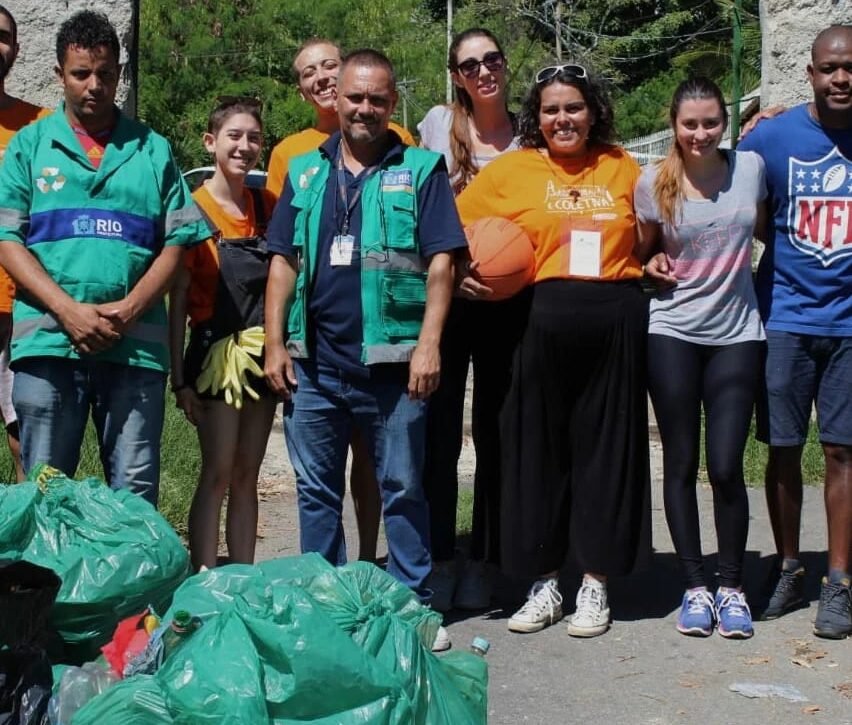
Corrêa sees collective work and the spreading of good practices as the path to mitigate and face the consequences of the climate crisis: “What does it take to try, in some way, to reverse this situation? Unity, putting yourself in other people’s shoes, knowing that your attitudes generate inevitable consequences—like this tragedy [the climate crisis] foretold by science for years and ignored by public authorities. Many people are already doing great things, but unfortunately not everything reaches everyone. I want to add my efforts to this larger tide,” says Corrêa.
Environmental action and climate concerns are common to many initiatives and leaders that are part of the Sustainable Favela Network. Bruno Almeida from Santa Cruz, in Rio’s West Zone, also wants to add his strengths to a larger effort. A historian, he works at the Center for Orientation and Historical Research of Santa Cruz (NOPH), an initiative that integrates the SFN’s Local Culture and Memory thematic objective. In Almeida’s understanding, “climate justice refers to the idea that we live an injustice with regards to the climate, an injustice produced by our way of life which harms us, especially black, peripheral people. It harms all living beings on the planet who, like us, depend on a healthy planet to continue to exist.” Almeida continues: “Without public authorities keeping a keen eye on things, the poorest will still remain on the sidelines and affected by environmental racism.”
Environmental racism and climate justice are complementary notions. In essence, environmental racism relates to the profile of the people affected by the lack of access to natural resources, by the consequences of policies and negligent actions regarding the environment.
Some everyday examples can help us understand this. What parts of the city have the lowest levels of basic sanitation? Where are the garbage dumps and landfills that concentrate the waste collected in a city? Who are the people most affected by the lack of water? What is the color, social class, and address of these people? If these problems are concentrated in peripheral areas, such as the favelas and Baixada Fluminense, they constitute environmental racism because they harm specific populations—especially black people, who are the majority in these territories.
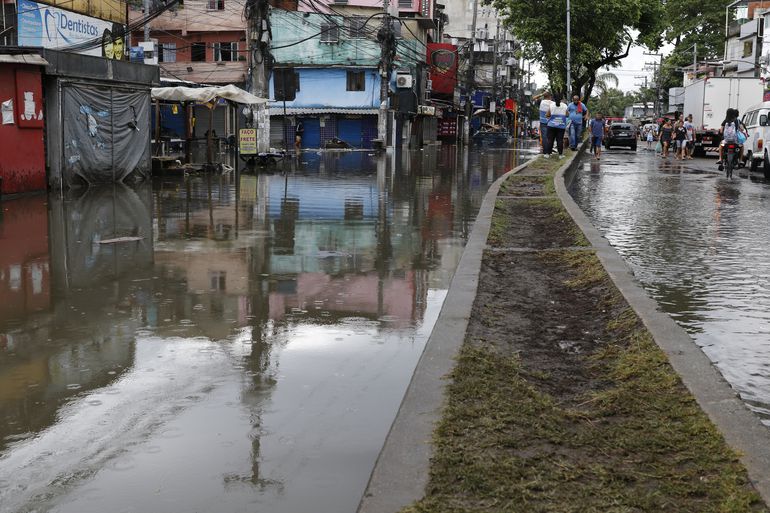
As natural resources are neglected and we exceed the planet’s capacity to absorb the impacts, the environmental crisis expands into a climate emergency. For Hanna Cavalcanti, an environmentalist with the Plant in the Street collective, located in the Cantagalo favela in Rio’s South Zone but active throughout the city, this relationship became quite explicit with the arrival of the coronavirus pandemic. She argues that “to some extent, the pandemic contributed to speeding up this change [of awareness]… at least for some people who understood everything that is going on.” The initiative is part of the SFN Food Sovereignty thematic objective.
Climate Justice in the Rio de Janeiro Context
Coastal cities such as Rio de Janeiro are particularly threatened by climate change. With the warming of the planet, glaciers are melting and sea levels are rising, advancing toward the cities. The municipality of Atafona, on the north coast of the state of Rio, is a great example of these consequences. Atafona is the Brazilian town most affected by erosion and shrinking shores, a phenomenon that has already destroyed hundreds of houses. Rising seas, however, are just one of the many consequences of the climate crisis.
Heat waves, extreme droughts, floods, loss of human and agricultural productivity, species extinction, and forced human displacement are some of the observations made in the 6th IPCC Report. According to the report, some of these consequences are already irreversible. It is urgent to reduce emissions to slow down the more severe impacts and adapt to this new reality. Public policies and community initiatives can be fundamental for this.
One example that emerges from the Rio de Janeiro context is a state policy that supports urban agriculture. Law 8366/2019 seeks to support, encourage and protect areas of urban agriculture, guaranteeing food and nutritional security for the population of Rio. The law also aims to stimulate a solidarity economy, generating income for associations and cooperatives while also encouraging the creation of green spaces to control pollution and erosion, protecting fauna and flora.
“We [also] came to support city councilors who put forth proposals, albeit with difficult approval, to reduce the value of the property tax paid by those who can demonstrate they are reforesting the green areas around their home, street, in squares, and the like… There are several paths to take with small urban, peripheral, and community forestry. There is technological knowledge available that can simultaneously offer financial compensation to the population, attract birds, reduce the heat and stop deaths from landslides. So we have a vast and promising field there,” says State Deputy Carlos Minc.
Rio has relevant policies, though sadly many are not carried out. As a result we typically depend on solutions that emerge from civil society. One example is the Providência Agroecological project, led by three women: Elisângela Almeida, Lorena Portela and Alessandra Roque. The collective was formed in 2015 after Almeida participated in a leadership training course through the Networks for Youth Agency. At the time the Intelligent Garden project was born, an environmental education project aimed at children, combining food cultivation with the restoration of degraded areas in Morro da Providência. Shortly after, Almeida met Portela and Roque, who have now come together in the Providência Agroecological initiative.
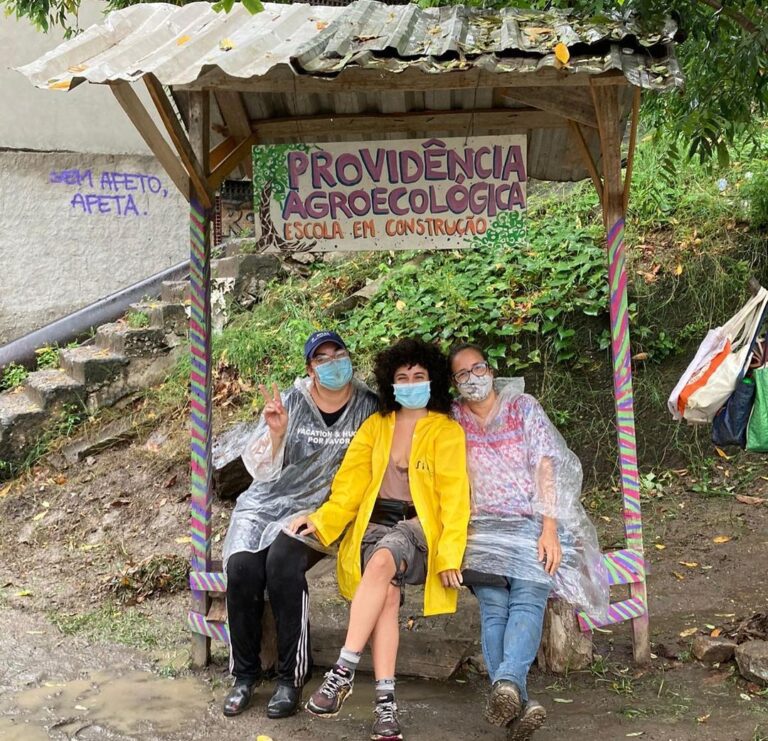
The organizers work voluntarily and, with much effort, built a headquarters for the project. There are over 500 species of vegetables and medicinal plants in the space. The initiative offers daily planting activities, workshops for children and food. “What we do inside Morro da Providência involves climate justice,” explains Almeida. “Our reforestation, food planting, and ecological education are linked to the strengthening of health practices based on traditional knowledge with the use of medicinal plants. We understand that we contribute to the resilience, autonomy, and strengthening of the territory and also to the resistance of adverse effects of climate change. We achieve thermal comfort when we have a reforested and ecologically balanced environment. We are able to access some foods without having to depend on very long harvesting periods, non-local crops, or the variability of food prices that are inevitable during crises,” she concludes.
The production of clean and renewable energy is another path proposed by favela initiatives in Rio. Revolusolar, Brazil’s first solar cooperative, has been operating in the South Zone communities of Morro da Babilônia and Chapéu Mangueira since 2016. The solar energy project is centered on the training of local workers, income generation, and environmental education. Its distributed generation system benefits 34 families, whose monthly electric bills have been reduced by 30% while benefiting from clean energy.
For Eduardo Ávila, executive director of Revolusolar, which is partnered with the SFN’s Energy Justice thematic objective, the ideas of climate justice and energy justice intersect with the notion of democracy. “Climate justice and energy justice are about democratizing not only the responses to mitigating the climate crisis, but also the opportunities for sustainable development that arise from it, such as renewable energy.”
Bringing energy production closer to where it is consumed generates not only financial savings but above all resources. For Ávila, the presence of solar panels and this process in the daily lives of communities also plays a role in raising environmental awareness. “We see solar panels as a mechanism for environmental education and community engagement in the theme of sustainability, as it brings what was previously something distant from consumers closer to them. Solar panels allow us to see energy as it is being generated and to participate in the system. This helps us understand what is behind it and consequently point us in the direction of truly solving the problem for people and communities, democratizing [access to energy].”

Rio de Janeiro is the second largest city in Brazil and, like most large urban centers, was founded and structured on systems of capitalism and colonialism. One of the most concrete consequences of this is the hierarchy in the relationships between species, gender, class, and race, making nature and certain individuals and communities more vulnerable. This is presented in different ways, including the negligence of social agents and public authorities in the way natural resources are used, territories are occupied, and cities are structured.
The periphery and its residents pay the highest price. At a global level, southern countries like Brazil are on the periphery of the international political and financial systems. Compared to the richest nations, the developing countries of Latin America, Africa, and Asia will experience the most dire consequences of climate change. Regarding this, Jane Matos, known as Janinha, argues: “Climate change is unfair because those who are the most to blame for global warming are the ones who suffer the least from its consequences and transformations.”
For Janinha, the richest countries, with their large industries, are the ones that contribute the most to greenhouse gas emissions, but other nations cannot be exempted from being held accountable. “It’s the same in Brazil because they do not respect nature and cause tragedies for the people and the world,” she concludes. Janinha lives in Queimados, in Baixada Fluminense, and works with the college exam preparatory course at Educafro.
Climate justice is at the center of the agenda and debate proposed by the Sustainable Favela Network, which this year os promoting a series of activities and events on the topic. Although, at first glance, the term may seem distant from the reality of favelas, they experience the concrete consequences of the lack of climate and environmental justice daily. The first step to seeking climate justice is through the participation and voices of people and communities most affected by climate change.
About the author: Beatriz Carvalho was born and raised in Vilar dos Teles, São João de Meriti. She is a journalist, media-activist, feminist, and founder of Mulheres de Frente.
*The Sustainable Favela Network and RioOnWatch are both projects of NGO Catalytic Communities (CatComm).
